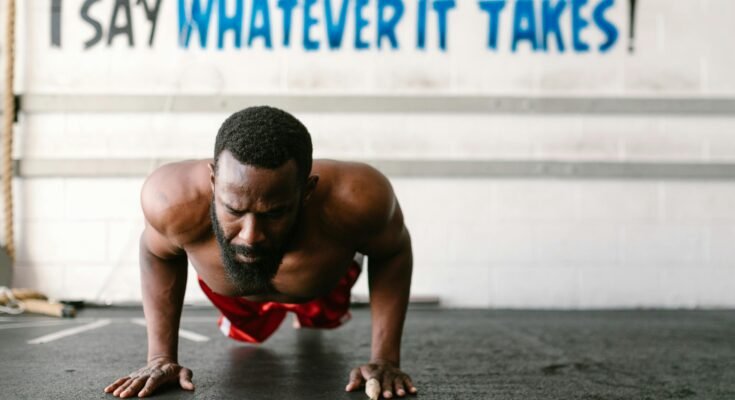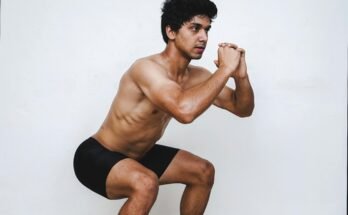In the hustle and bustle of life today, always being fit could be more challenging. Thankfully, bodyweight exercises are a remarkably effective and accessible way to give you the full-body workout you need 🙂 They are bodyweight exercises that are performable anywhere and for all fitness levels. This extensive guide will look at numerous bodyweight exercises and their benefits, along with how you can structure your workout routine and, eventually, some advice to keep motivated and stay healthy.
Bodyweight Training Explained
What are calisthenics?
Bodyweight exercises are strength training movements that do not require free weights; the individual’s body weight provides resistance against gravity. Simple push-ups, squats, burpees, and planks are such exercises. As they use the weight of your body, these can be done anywhere, making them a very practical option if you are pressed for time.
Advantages of Bodyweight Exercise
No gym membership or fancy equipment is needed. When traveling, you can do these exercises at home, in a park, or even in your hotel room.
Modifiability: Bodyweight exercises can be easily adapted for beginners and experienced athletes as long as you have a strategy.
Functional Fitness: Workouts help you develop your capacity for daily living activities.
Stability and Coordination: Some bodyweight exercises recruit more than one set of muscles, which helps stabilize other muscle groups.
Cheap: These are times when people do not have money to buy exercise equipment at home but need a way of staying fit.
Cardiovascular Benefits: Bodyweight circuit training enhances your cardiovascular system, increases your heart rate, and burns calories.
Endurance (Muscular): Body weight exercises are usually performed with high repetitions, which may improve muscle endurance and stamina over time.
Healthy Core: All these exercises target your core, essential for overall strength.
Bodyweight Basics for Full-Body Training
Important bodyweight exercises for each muscle group in your entire body are:
1. Push-Ups

Muscles Worked: Chest, Shoulders, Triceps and Abs.
How to Perform:
Begin in a push-up position with your hands just wider than shoulder-width apart.
Bend your elbows to lower your body until you reach the floor.
Now, push yourself back up to the top.
Variations:
This variation is superb for a beginner, as you can simply place your hands on an even surface.
Reverse push-ups on a slope: You would elevate your feet to make them more challenging.
Diamond Push-Ups: Place your hands together under the chest for more tricep emphasis.
2. Squats
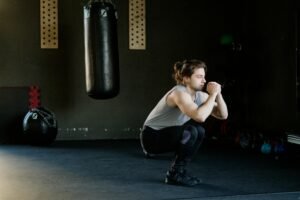
Primary Muscle Groups: Quads, Hams, and Glutes; A Lot of Core.
How to Perform:
Stand with foot width apart.
Keep the chest high, bend your knees, and send your arse back like sitting in a chair.
Chest up, back straight
Return to standing.
Variations:
Jump Squats: Introduces plyometrics to increase power.
Sumo Squats: Wider Leg Stance- Focuses on the Inner Thighs
Step ups: Added difficulty and balance requirementsBulgarian split squatsSingle-leg squat
3. Lunges
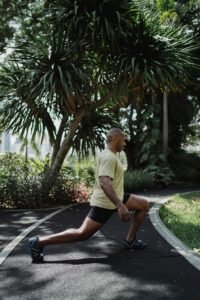
Primary muscle used: Quads, hamstrings, butt and calf
How to Perform:
Step to one leg, and stand up tall.
Squat down at your hips until both knees are bent about 90 degrees.
Then, push back to the start position and change legs.
Variations:
Reverse Lunges: The step behind you will provide a more stable support platform.
Walking Lunges: As the name suggests, walk a while with each lunge to enhance your workout.
Lateral Lunges- Step to the side and target your inner and outer thighs.
4. Plank

Primary Muscles Used: Central, Shoulder, and Back.
How to Perform:
Plank- Get in a push-up position on your elbows (as opposed to hands)
Ensure your body is straight from head through heels while engaging the core.
Keep this position for as long as you can.
Variations:
Side Plank: Balancing on one side targets the oblique.
Plank Shoulder Tap: Touch your opposite shoulder consecutively in a plank position.
Plank Jacks: Promote your feet out and, in a while, reaming inside the plank.
5. Burpees
Type: Full BodyMuscle Groups: Chest, Arms, Legs and Core
How to Perform:
Start in a standing position.
Squat down and put your hands on the ground.
Push your feet back into a plank position.
Push-Up optional + Jump your feet back to the Squat position.
Explode upward into a jump.
Variations:
Half Burpee: A less intense modification here is to eliminate the push-up.
Burpee Tuck Jumps – Do a tuck jump at the top for an added power burst.
Tuck Burpee: Jump forward instead of vertically.
6. Mountain Climbers

Muscles Worked: Core, Shoulders, and Legs.
How to Perform:
Start in a plank position.
Bring one knee into your chest, then switch sides fast.
Do 50 reps by changing legs every time, and repeat as fast as possible.
Variations:
Cross-Body Mountain Climbers: With a twist (bring knee to opposite elbow for oblique action). 4.
Mountain Climbers (slow): Slowing them down gives beginners more time to think of proper form.
Add Resistance to Waisted Mountain Climbers with a Weighted Vest.
7. Tricep Dips
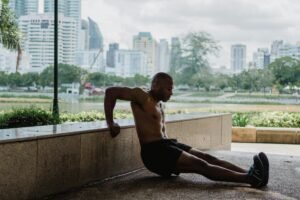
Goals: Triceps, shoulders, and chest.
How to Perform:
Find a sturdy bench or chair.
Sit on the ground with your legs extended (for working upwards) or stand at the edge of a chair with palms beside you and hands facing front.
Move on to your edge and descend by bending the elbow
Push back up to the start position.
Variations:
Single-Leg Tricep Dips: Single-leg tricep dips are an excellent exercise for the extensor of one foot and balance.
Bench Dips- Use Two Bench insets for more difficulty.
Weighted DipsAd a weight plate on your lap.
8. Glute Bridges
Glutes, hamstrings and lower back
How to Perform:
Curl onto your back with knees bent and both feet flat on the mat.
Lift your hips to the sky, squeezing at the top
Lower back down and repeat.
Variations:
Pistol Bridge: Extend one leg up as you lift your hips.
Plate Glute Bridges: Add a plate on your hips for more strength.
Marching Glute Bridges (Bridge position with one foot lifted)
9. Bicycle Crunches
Primary Muscles Targeted: Abs and obliques
How to Perform:
Recline on your back, knees bent with one hand behind the head.
Draw your right knee into your chest while slowly twisting the left elbow towards that bent knee.
Flip over and pedal your legs like a bicycle.
Variations:
Slow Bicycle Crunches: Perfect for newbies wanting to concentrate on type and manage.
Weighted Bicycle Crunches (with a weight plate to make it more challenging)
V-Ups — Lift Legs and Upper Body together to engage your whole core.
10. High Knees
Primary Muscles Worked: Quadriceps, Hamstrings – and also all other muscles in the legs/core/cardiovascular system.
How to Perform:
Stand with your feet hip-width apart
Bring them up to your hip level, running in place.
Swing your arms for even more drive.
Variations:
Beginner- High Kness Ssssllloooowwww: Roll the foot in a waving motion |_|; focus more on form and height than speed.
Weighted High Knees: Carry a pair of dumbbells to increase the intensity.
High Knee Sprints — More Speed = Harder workout
Bodyweight Exercise Program
Here’s what an ideal bodyweight exercise plan might be:
1. Warm-Up
Proper warm-up is also necessary to prepare the body for heat. Of course, heat can promote injury. The proper warm-up should take 5-10 minutes, during which time perform dynamic stretches. Light cardio examples include jogging in place or jumping jacks.
Dynamic Warm-Up Examples:
Warm-up: Arm Circles (forward and backward) to help loosen the shoulders.
This will improve hip and leg mobility.
Torso Twists: Warm up your core by twisting from the torso.
2. Structure Your Workout
Try to incorporate strength, cardio, and flexibility into each workout. Here is a sample bodyweight workout for you —
Sample Routine:
Warm-up: Dynamic stretches — 5–10 minutes
Push-ups 3×10-15
Squats: 3 sets of 15-20 reps
Front lunges: 3×10-12 reps per leg
Plank (3 sets, 30 to 60 seconds)
Burpees: 3 sets of 8-10 reps
Mountain Climbers (3 sets 30-45 seconds)
Tricep Dips: 3×10-15 reps
Glute Bridges(15-20 reps), 3sets
Bike Crunches: 3 sets of 15–20 reps per side
High Knees (x3 @ 30–45 secs.)
Cooldown: 5-10 minutes of stretching or targeted mobility work
3. Progression and Modification
However, build up gradually to ‘higher’ intensities as you strengthen. You can achieve this by:
Increasing The Repetition Or Sets: Do more reps or sets each week as you go along.
Cut the Rest Time Between Sets Increasing training intensity.
Leveling Up Your Workout — After mastering the basics, add more advanced variations.
Beginners should have a firm grasp of the basics before moving on to more challenging versions.
4. Frequency
Ideally, you should perform bodyweight fitness 3–4 days per week to maximize results. Take rest days to recover your muscles.
5. Balancing Workouts
Switch up the focus of your workouts to guard against overtraining and balance muscle growth. For example, one day might be upper body focus and the next lower. This can aid in muscle equilibrium and lessen the chance of injury.
Tips for Success
Remain Steady — To get results, you have to be consistent. Set your workouts up as if they were like any other meeting,
Listen to Your Body: Focus on what your body is telling you. If you are feeling pain, it is time to reevaluate your position or take a break until the new tips can be applied to return no more sanctions.
Set Your Goals Straight Then, you need to set your goals with proper specificity and ensure they are measurable to keep yourself motivated.
Monitor your Progress: Keep a workout journal to track changes and progress and celebrate victories.
Mix Up Your Workouts: Try different exercises and change your routine every 6–8 weeks to stay interested.
Stay Hydrated: Keep a bottle of water with you when working out, and drink before, throughout, and after workouts.
Rest: To optimize your mental capacity and avoid burnout, rest is essential.
Adding More Bodyweight Training Into Your Life
Outdoor Workouts
If you enjoy the great outdoors, do a bodyweight workout at every park or in your backyard on grassy land or a sand beach. The natural environment gives you relief that can change your mood and motivate you.
Group Workouts
Get involved in a local exercise group or plan workouts with friends. We tend to be more accountable when working with others; exercising together can add fun to your workout.
Online Resources
Use body-weight workout routines with instructors from fitness apps and YouTube. Tools like this can help steer your workouts in the correct direction.
Family Involvement
Get your family involved in body-weight exercises. This helps them lead a healthy lifestyle and creates fun bonding time. Most basic movements, like squatting and lunging, can be gamified.
The Importance of Nutrition
Training is nearly impossible to outtrain a poor diet. Consider the following as part of your bodyweight training support structure.
Eat Well: You need a mix of balanced foods to work out, and ideally, this should come from your conventional meals alongside the pre- and post-workout items.
Hydration: Before your workout, during the exercise, and for recovery, drink more water.
Post-Workout Nutrition: Eat a combination of protein and carbohydrates within 30–60 minutes after your workout to help repair muscle.
Sample Meal Ideas
Pre-Workout Snack: Banana topped with peanut butter or berries over Greek yogurt.
Post-Workout Meal: chicken grilled with quinoa and vegetable steamed or protein smoothie, spinach, fruit
Staying Motivated
The reason for wanting to exercise. — Find Your Why Whether it is to improve health, increase strength, or uplift yourself with a much-needed happiness-boosting session – remembering what sparks your motivation keeps you going for longer.
Build a Positive Atmosphere: fill in your life with friends impressing you. Take this shower every day.
Treat yourself: Set small goals for yourself and then treat yourself when you reach that goal. That often looks like a new workout top or treat of my favorite healthy meal.
Finally, (6) Visualize Success: Take some time to visualize your goals and what achieving them will feel like. This could boost motivation and commitment.
Champion a Challenge: Enter hit fitness challenges, including live events or online. This idea is not bad—it gives you structure and community support.
Conclusion
While it may seem surprising that bodyweight exercises can be the key to a well-rounded fitness practice, they offer many benefits no matter where you are on your fitness journey. You can achieve strength by including these exercises in a balanced workout routine.
